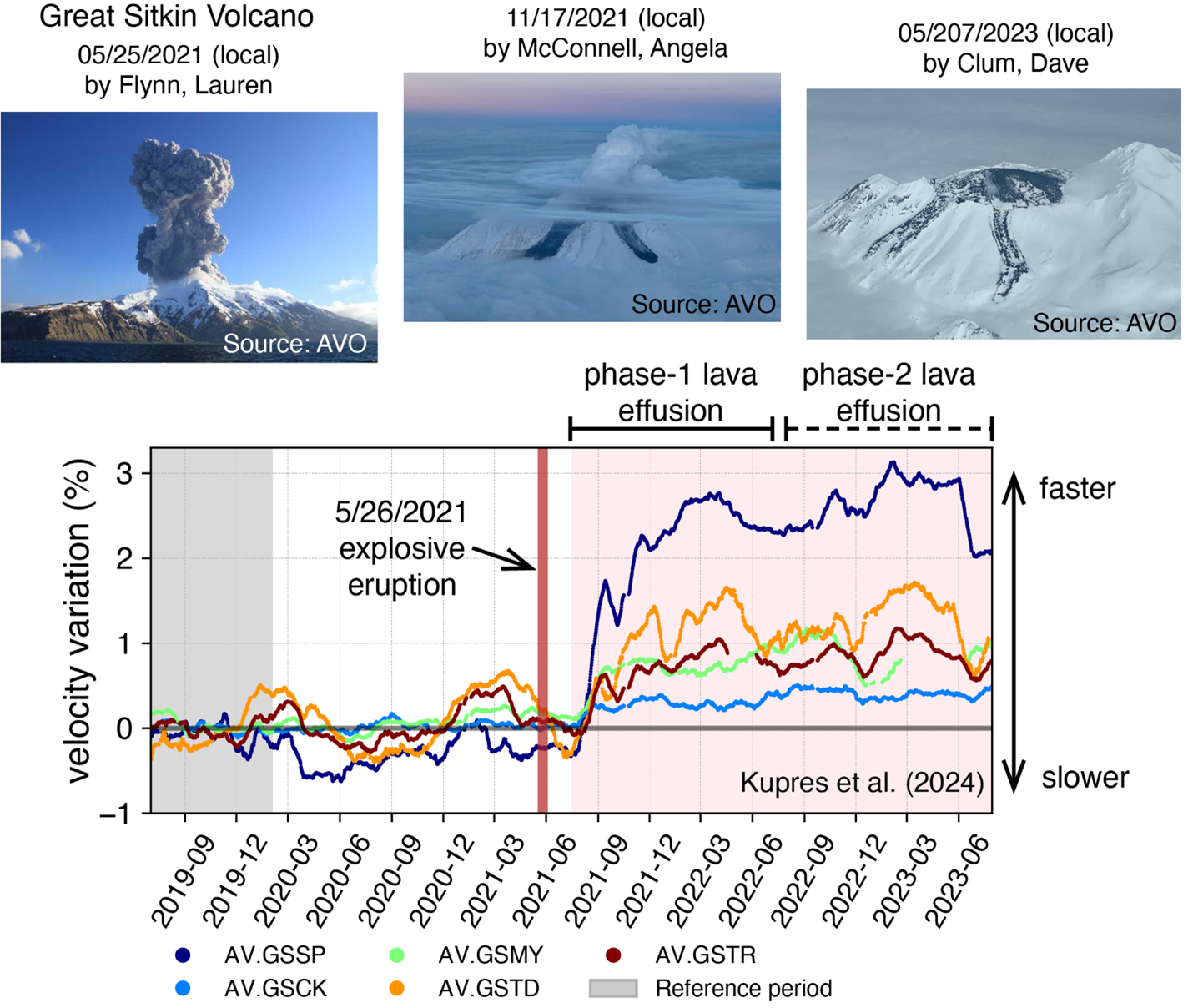Purdue seismologists use new technique to determine activity below the surface of an Alaskan volcano
09-20-2024

Volcanic eruptions provide important insights into how volcanoes work and the potential risks they pose to nearby regions. Great Sitkin, a volcano located in Alaska, has been in an ongoing eruption since May 2021 and is providing scientists with a tremendous amount of data. This volcano, found in the in the central Aleutian volcanic arc, is helping researchers better understand the property changes beneath the surface during the eruption.
Xiaotao Yang, assistant professor with Purdue University’s Department of Earth, Atmospheric, and Planetary Sciences, and recent MS graduate Cody Kupres used an emerging technique using the seismic energy produced by ocean waves to measure subtle changes in the velocity of seismic waves propagating across the volcano below each seismic station on the island. They published their findings in The American Geophysical Union’s Geophysical Research Letters.
“We analyzed four years of data from July 2019 to July 2023, covering multiple lava effusion episodes,” says Yang. “Our results show that, with the onset of lava effusion, the subsurface (dominantly the top 1-2 km below the surface) became seismically faster than that about two years before the eruption. This observation is the most prominent at a station northwest of the volcano's central crater. We argue that this increase reflects the structural change in the shallow subsurface due to the deflation of the edifice with magma withdrawal and closure of cracks that opened during the pre-eruptive pressurization stage.”
The team observed prominent, spatially variable increases in seismic velocity during the entire lava effusion stage at Great Sitkin Volcano, with variations in amplitudes across multiple lava effusion episodes. The findings document spatially variable transient changes in shallow subsurface structure below active volcanoes that may be controlled by reservoir geometry or strength of the shallow volcaniclastics.
“It was exciting to contribute to this growing field, as more varied and distinct volcanic activities are being characterized using this emerging technique,” says Kupres. “Before our study, there was a knowledge gap regarding how subsurface structures (e.g., seismic velocities in our case) would respond to the formation of a lava dome. Great Sitkin presented a perfect opportunity to address that.”

Great Sitkin Volcano has a peak elevation of 1740 meters and occupies the majority of the northern side of Great Sitkin Island. The explosive eruption that started on May 26, 2021, lasted for 1-2 minutes. It was followed by a two-month quiet period before the onset of the continuing effusive eruption and the emplacement of a lava dome since about 18 July 2021. Local earthquakes are concentrated within a northwest-southeast zone, shallowest below the caldera.
The nearest town is Adak, which is about 30 miles to the southwest of Great Sitkin. Eruptions at the volcano may produce explosive ash plumes of up to several kilometers high, which will influence air traffic in the surrounding region. Lava overflows onto the flank, contributing to the long-term development of the volcano edifice.
Modern technology allows research teams to study this volcano from seismic data. The high-performance computing clusters at Purdue University allow researchers at the West Lafayette campus to implement advanced seismic waveform-based methods in studying this volcano.
The team consisted of Kupres (lead author) and Yang, both from Purdue University, as well as two external collaborators Matt Haney, of USGS and Alaska Volcano Observatory, and Diana Roman, of the Earth and Planets Laboratory at Carnegie Institution for Science. Yang initiated the project, supervised the data processing, interpreted the results, and supervised on writing and reviewing of the manuscript while Kupres carried out data processing, interpreted the results, and wrote the original manuscript. Haney assisted with data collection, interpreted the results, reviewed and edited the manuscript. Roman interpreted the results, reviewed and edited the manuscript.
This research is ongoing for Yang. He says he hopes that their work could motivate instrumentation at Great Sitkin to further evaluate the team’s hypotheses proposed on the control of transient subsurface structure below active volcanoes.
“We will also test the hypotheses at other active volcanoes to comparative studies,” says Yang. “This is our second paper on Great Sitkin, following another paper last year on seismic tomographic imaging of the magma reservoir. Moving forward, we hope to put more seismometers on the island to enable a more detailed imaging and monitoring study. This work is also part of our research effort on seismological study of the structure and dynamics of active volcanoes and their eruptive behaviors.”
This work is part of Kupres’ master’s degree thesis. Cody graduated in the Spring of 2024 and is currently working as a LiDAR Data Analyst at Bridger Photonics, Inc. This work is supported by the startup funding for Dr. Xiaotao Yang at Purdue University.
About the Department of Earth, Atmospheric, and Planetary Sciences at Purdue University
The Department of Earth, Atmospheric, and Planetary Sciences (EAPS) combines four of Purdue’s most interdisciplinary programs: Geology & Geophysics, Environmental Sciences, Atmospheric Sciences, and Planetary Sciences. EAPS conducts world-class research, educates undergraduate and graduate students, and provides our college, university, state and country with the information necessary to understand the world and universe around us. Our research is globally recognized, our students are highly valued by graduate schools, employers, and our alumni continue to make significant contributions in academia, industry, and federal and state government.
Contributors:
Xiaotao Yang, assistant professor with the Department of Earth, Atmospheric, and Planetary Sciences at Purdue University
Written by Cheryl Pierce, Lead Marketing and Public Relations Specialist for the Purdue University College of Science